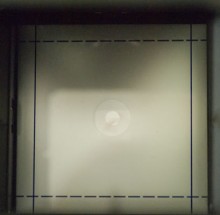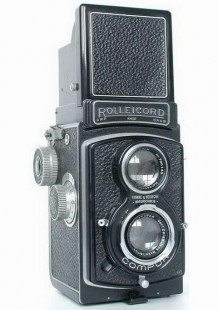I recently made a new focusing screen for my SL66 and am delighted with the result. No photos I’m afraid as I wasn’t sure how successful the new screen might be. I don’t claim to have thought of this myself but it is such a good idea that I feel sure others may be interested. It may also work with TLR cameras as well.
The original focusing screen on my SL66 has seen better days; it is scratched and marked in several places. The outer area has a very grainy appearance and I found myself lining up horizontals or verticals with the engraved lines, even when it wasn’t necessary. I like my screens to be as uncluttered as possible. Furthermore, whilst re-setting the focusing on my camera, I discovered that the microprism focusing in the centre spot of the original screen would allow a slight change in lens position without de-focusing in the microprism. Not a lot, but enough to make the difference between razor sharp and OK sharp. This may be due to my ageing eyesight but past experience had taught me that microprisms are not ideal for obtaining precise focus.
What I wanted therefore was a nice bright screen, without the grainy appearance, without engraved lines, and a ground glass, or equivalent, central area for precise focusing. The modern super bright Rollei 6000 series screens will fit the SL66, I could buy a Beattie screen or could have a screen made for me by Bill Maxwell in the US, but none of these options are cheap. As well as my SL66 I also use a Mamiya 645 Pro and this has a screen that matched my requirements exactly, but was too small to be used in the SL66. However Mamiya also make the RB and RZ67 series and as these cameras have revolving backs, their screens have to be larger than a straight 6x6 screen.
I found what I was looking for on eBay and won the auction with a $30 bid plus postage. Whilst waiting for the screen to arrive I adjusted the focusing on the SL66 using a ground glass screen, lots of patience and lots of film. By the time it arrived I was happy that the focusing was as good as could be without having an optical bench. Using the original Rollei screen centred over the Mamiya, I carefully scored the new screen around the edges of the original with a scalpel about 10 times on all sides using masking tape to hold the two screens together, flat side to flat side and taking the usual precautions for my own safety and to prevent the new screen from being scratched. I then carefully lined up the score marks over a straight edge and snapped off the excess screen area with pliers.
This left me with rough edges that were equally carefully filed and sanded down using a blower and Kinetronics brush to clean the screen of debris after every operation. It is absolutely essential that there are no rough edges left on the new screen that might prevent it from seating correctly in the camera, so all edges were chamfered back to about 1/2 mm with 220 and 400 grade sandpaper. Running a fingertip along the edges I could feel any raised areas that had to be removed. It then only needed me to verify that the new screen was seating correctly.
For this I taped a sheet of newspaper on the wall, set up the camera about m away with the 80mm lens mounted. I removed the ground glass screen from the screen frame and simply dropped it, matt side towards the mirror, into the screen aperture so that it rested on the side registration bars (the ones with adjustment screws at both ends), and used an 8x magnifier to get the focus as precise as possible. Swapping the ground glass for the new screen – also matt side down - I could see that the focus point was identical. I then put the new screen into the screen holder and checked again before replacing the focusing hood.
For $30 odd and an hour’s work I now have a bright, unscratched uncluttered screen with a precise focusing area in the centre. I am delighted with the result and will now look for a Mamiya RB screen with engraved lines to replace the original Rollei screen for architectural work.
Disclaimer: The author accepts no responsibility whatsoever for anything that may happen to anyone or any thing at any time as a result of this article. If you do not like these conditions – DO NOT DO IT.
Post Script: Although I have not had any problems (so far) using the cutdown RB67 screen, I have a word of warning about using RB screens, written by Bill Maxwell who makes the Maxwell screens: The Maxwell HI-LUX Micro/Split RF (Type II) screen is almost f: stops (4 times) brighter than the RZ67 focus screens. While the HI-LUX Brilliant Matte screen is about 3 f: stops (8 times) brighter than the RZ67 focus screens. Also, the RZ67 focus screens are not meant to be used without a cover glass. The RZ67plastic focus screens are not flat. They are bowed upward so that when they are held tightly in the Mamiya metal frame, the cover glass will press down on the top of the screen and hold the screen flat. You may have a small focus error when using this screen. Maxwell screens are vacuum annealed to ensure that they are flat. These screens are as flat as the Rollei factory screens (as measured by a surface comparator), so there should be no focus change So maybe it isn’t quite such a good idea after all - however, as I said originally, I did check the focus with the RB screen against the original Rollei ground glass screen and it looked fine to me. Wishing you a Happy 2008

